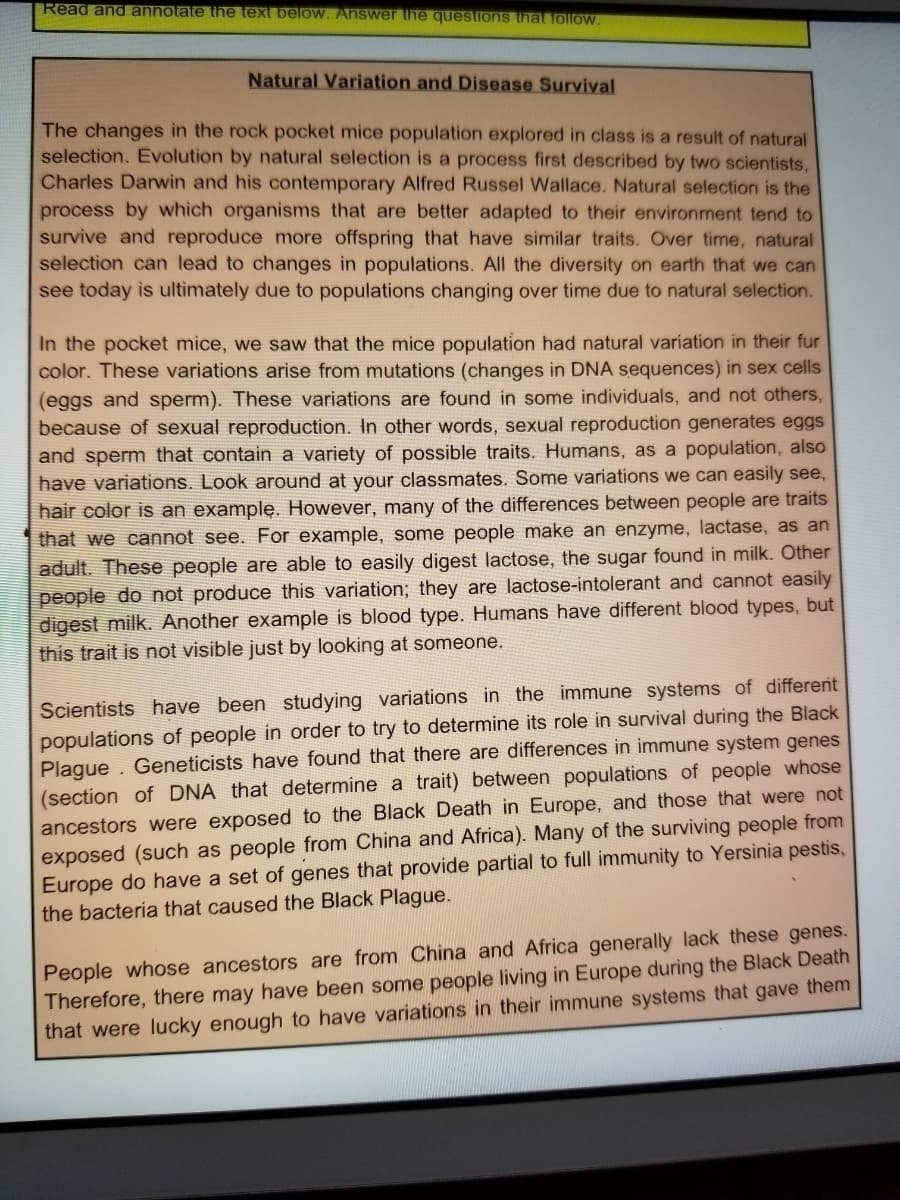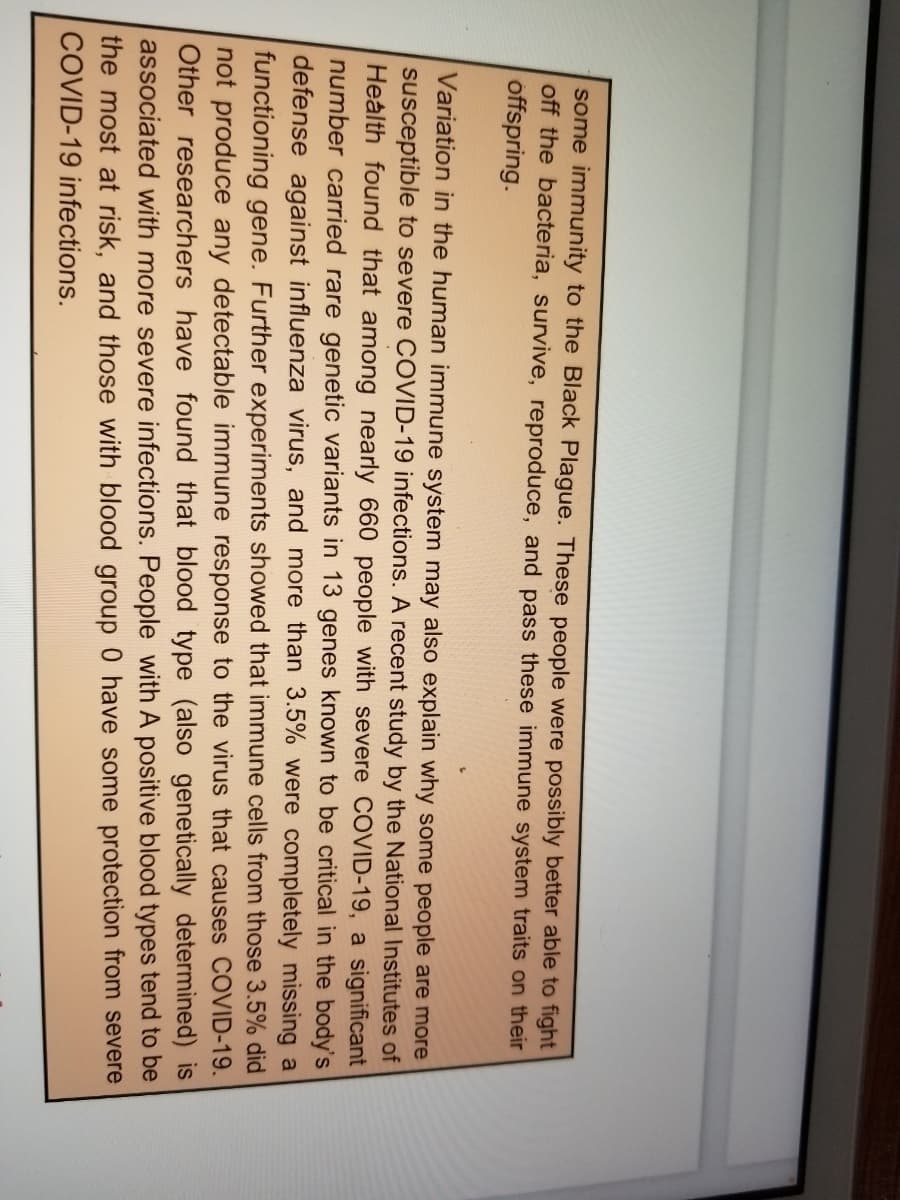Using evidence from the text, how did natural selection determine the survival of medeival humans during the black death( bubonic plague)? Please explain in 4 to 4 sentences Use the words: variation, natural selection, favorable traits
Using evidence from the text, how did natural selection determine the survival of medeival humans during the black death( bubonic plague)? Please explain in 4 to 4 sentences Use the words: variation, natural selection, favorable traits
Medical Terminology for Health Professions, Spiral bound Version (MindTap Course List)
8th Edition
ISBN:9781305634350
Author:Ann Ehrlich, Carol L. Schroeder, Laura Ehrlich, Katrina A. Schroeder
Publisher:Ann Ehrlich, Carol L. Schroeder, Laura Ehrlich, Katrina A. Schroeder
Chapter10: The Nervous System And Mental Health
Section: Chapter Questions
Problem 29LE
Related questions
Question
Using evidence from the text, how did natural selection determine the survival of medeival humans during the black death( bubonic plague)? Please explain in 4 to 4 sentences
Use the words: variation, natural selection, favorable traits

Transcribed Image Text:Read and annotate the text below. Answer the questions that follow.
Natural Variation and Disease Survival
The changes in the rock pocket mice population explored in class is a result of natural
selection. Evolution by natural selection is a process first described by two scientists,
Charles Darwin and his contemporary Alfred Russel Wallace. Natural selection is the
process by which organisms that are better adapted to their environment tend to
survive and reproduce more offspring that have similar traits. Over time, natural
selection can lead to changes in populations. All the diversity on earth that we can
see today is ultimately due to populations changing over time due to natural selection.
In the pocket mice, we saw that the mice population had natural variation in their fur
color. These variations arise from mutations (changes in DNA sequences) in sex cells
(eggs and sperm). These variations are found in some individuals, and not others,
because of sexual reproduction. In other words, sexual reproduction generates eggs
and sperm that contain a variety of possible traits. Humans, as a population, also
have variations. Look around at your classmates. Some variations we can easily see,
hair color is an example. However, many of the differences between people are traits
that we cannot see. For example, some people make an enzyme, lactase, as an
adult. These people are able to easily digest lactose, the sugar found in milk. Other
people do not produce this variation; they are lactose-intolerant and cannot easily
digest milk. Another example is blood type. Humans have different blood types, but
this trait is not visible just by looking at someone.
Scientists have been studying variations in the immune systems of different
populations of people in order to try to determine its role in survival during the Black
Plague . Geneticists have found that there are differences in immune system genes
(section of DNA that determine a trait) between populations of people whose
ancestors were exposed to the Black Death in Europe, and those that were not
exposed (such as people from China and Africa). Many of the surviving people from
Europe do have a set of genes that provide partial to full immunity to Yersinia pestis,
the bacteria that caused the Black Plague.
People whose ancestors are from China and Africa generally lack these genes.
Therefore, there may have been some people living in Europe during the Black Death
that were lucky enough to have variations in their immune systems that gave them

Transcribed Image Text:some immunity to the Black Plague. These people were possibly better able to fight
off the bacteria, survive, reproduce, and pass these immune system traits on their
offspring.
Variation in the human immune system may also explain why some people are more
susceptible to severe COVID-19 infections. A recent study by the National Institutes of
Health found that among nearly 660 people with severe COVID-19, a significant
number carried rare genetic variants in 13 genes known to be critical in the body's
defense against influenza virus, and more than 3.5% were completely missing a
functioning gene. Further experiments showed that immune cells from those 3.5% did
not produce any detectable immune response to the virus that causes COVID-19.
Other researchers have found that blood type (also genetically determìned) is
associated with more severe infections. People with A positive blood types tend to be
the most at risk, and those with blood group 0 have some protection from severe
COVID-19 infections.
Expert Solution
This question has been solved!
Explore an expertly crafted, step-by-step solution for a thorough understanding of key concepts.
This is a popular solution!
Trending now
This is a popular solution!
Step by step
Solved in 2 steps

Knowledge Booster
Learn more about
Need a deep-dive on the concept behind this application? Look no further. Learn more about this topic, biology and related others by exploring similar questions and additional content below.Recommended textbooks for you

Medical Terminology for Health Professions, Spira…
Health & Nutrition
ISBN:
9781305634350
Author:
Ann Ehrlich, Carol L. Schroeder, Laura Ehrlich, Katrina A. Schroeder
Publisher:
Cengage Learning

Case Studies In Health Information Management
Biology
ISBN:
9781337676908
Author:
SCHNERING
Publisher:
Cengage

Medical Terminology for Health Professions, Spira…
Health & Nutrition
ISBN:
9781305634350
Author:
Ann Ehrlich, Carol L. Schroeder, Laura Ehrlich, Katrina A. Schroeder
Publisher:
Cengage Learning

Case Studies In Health Information Management
Biology
ISBN:
9781337676908
Author:
SCHNERING
Publisher:
Cengage